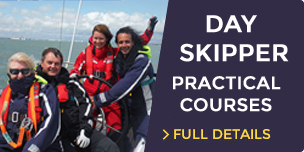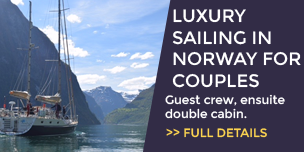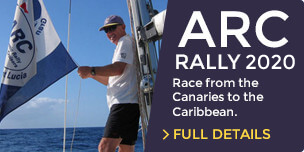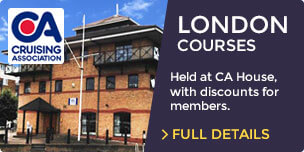What you Need to Know About Yacht Racing
417 views | April 29th, 2024We talk to Cameron Davies about all things yacht racing.
Cameron runs a fantastic yacht called Expresso Martini, on behalf of First Class Sailing. He and his first mate will take you out on the water, to get a real taste of life at the cutting edge of the racing world, in a safe and fully supported environment.
Giving you an experience and adrenaline rush like no other, combined with the satisfaction of working in a team that’s being tested to its limits.
Tell us a little about yourself
I’m a Yachtmaster Offshore commercially endorsed skipper.
That’s what I do for First Class Sailing – race a boat called Espresso Martini. I’ve been sailing for about 40 years. It started in dinghies, gone through sports boats into yachts, partly because dinghies is too physical for me these days. But partly also because you want to go further as your sailing career develops. I was lucky enough to have gone through the youth squad under the great Jim Saltonstall and his coaching experience, and it was absolutely fantastic, brilliant introduction to sailing.
Why Race? What got you into it?
I think there’s a combination of things you know, on the one hand there is nothing else but the wind, right? You’ve got the wind driving you. We’re an island race, we’ve blown along every day one way or another harnessing that to make the boat go as fast as possible on every angle of sail in every possible condition with a crew that may or may not have experience of doing this before.
That’s the buzz, right? You layer on top of that. The need to start, countdown, you know, five minutes, four minutes, one minute. The heart races, the excitement’s up, the adrenaline’s there, the crew are sharp. There’s lots of people looking from the deck telling you what other boats are doing.
There’s a milling around of a lot of boats. The bigger the boats are, the more intimidating that can be. But you have to go in with a plan for your start. You have to know where you’re going to be. On the longer races, where it might be two days, one day might be two days, five days, whatever it might be, the start is less important.
But still, that’s one of the initial bits of the excitement, is to get there over the start line and get clear and get a good start.
What do people need to know or think about when it comes to yacht racing?
Yacht racing provides the opportunity to sharpen up all of those skills that sailors know they have. So We’re hoisting the mainsail, we’re hoisting the jib, we’re trimming the mainsail, we’re trimming the jib, we’re flying a spinnaker. A spinnaker could be a complicated thing, in waves, in breezy conditions, there’s a lot to manage. We may have to jibe the spinnaker, you’ve got to bring the pole down inside the forestay, trip the spinnaker before you do that, reconnect it after the jibe, on a boat that’s moving from side to side and fore and aft, on a narrow bow.
Because it’s a race boat, it’s quite a platform to encourage you to get your balance right and your coordination of all these various activities right. And when you then go back to perhaps cruising or another form of sailing that you might do, you take all of that with you as a sort of learning.
And it just makes you think, okay, I’ve been now used to pushing a fast boat hard at speed. At speeds that I’m not used to, we’ll get 14, 15, perhaps 18 knots surfing down a wave routinely, and we’ll go up, we’ll go up wind, we’ll go up wind in 8 knots, 10 knots of true wind, we’ll be going up wind at 6, 7 knots, so it’s immediate. You really get a sense of, okay, well, this is what I can do.
And one of the other great things when we’re going upwind is, our tacking angle is really small compared to cruising boats. So we’re tacking at 38 degrees, either side of the wind, it’s phenomenal. And so we make quick progress over the race course, over the ground.
And that’s exciting, right? And you know, giving people the experience of that, is wonderful because they enjoy it. And when they then do step back to whatever it is is their normal form of sailing, I think they’ve just developed a confidence around sail handling, around boat trim, around sail trim, around spinnakers if they want to use them, that they wouldn’t have had.
Tell us about the team-building aspect.
I started in dinghy sailing, two man boats, single handed boats, you’re doing everything yourself. There comes a point where the boats get large enough for you not to be able to do that, and you need other people to be able to contribute.
But the whole coordination say between helm and mainsheet, if the mainsheet person has not released the main at a time that I need to duck, if I’m helming, duck behind a boat, we’re not moving. We’re going to hit that boat. And if it’s a big drop down behind a boat, if we’re on port tack and we need to give way to a starboard boat and it’s a half a boat length or a full boat length, we need to duck down and it’s breezy, the main needs to come off, the jib needs to come off too.
So you need a main sheet trimmer, you need a jib sheet trimmer, all to be coordinated with the helm. And you don’t want to be doing this and losing speed. So, you drop down, keep the speed on, come back up, and try and get nice and tight to the stern of the starboard tacker. Come back up onto the wind again, all of that coordination that people need on a boat. That’s three or four people working together to develop ultimately some kind of intuition between you all.
And that comes with time, practice and experience?
Exactly. And again, when you take that back to your boat, you realise that it’s a very manageable thing – actually I can get closer to that vessel than I thought I ever could, and I can do some racing. An example, Round the Island Race – it’s a race for all. So you can do the IRC classes as we do. We’re an IRC one boat. Or you can enter in as a cruising class, cruising racing class, and you can do something at a different level. It’s still a race, right?
Perhaps it’s something you never thought of doing before, but now you can.
Tell us about the racing opportunities at First Class Sailing
First Class Sailing is a London and Southampton based sail training company. We charter Espresso Martini into First Class Sailing, we love working with them, they’re a fantastic set of people. And, they provide people for us to take out for this experience.
So, it can be everything from The Fastnet to Round the Island. We can do inshore racing, and we can do smaller offshore races in the Fastnet. The calendar is a full calendar, there’s no end of weekends to take part in through the summer.
What is the racing like in the Solent?
It offers everything really. And it offers a ruggedness, and yet without it being too wild. So, you’ve got the protection of the Hearst Narrows, so the seas can’t quite get that big, but they can get big enough.
And you’ve got wind against tide, you’ve got quite a ferocious tide at times. Yacht racing in the Solent will start this year with the Knab Tower Race, 23rd of March, so it’s a 35 mile race from Cowes. Out to the east, round the Knab Tower and back. The following day is a race out to the west, slightly shorter, 25 miles.
And you’ve got the south west facing western Solent, and the kind of south east facing eastern Solent – and a lot of water between the two. So it covers a lot of wind directions that you can Well, basically there’s not a wind direction. that doesn’t allow you to set a course, if that makes sense.
Tell us about the process someone new to sailing might go through.
We start the season March, April, depending really where Easter lies. It will start with the Winter Series racing, that’s usually run by Warsash or one of the other clubs.
That will involve day sailing, Sunday racing, and two weekends, full weekends, Saturday and Sunday, which are within that programme, but also independent of it. So you could just do those four days over two weekends. It does not include racing over Easter. Easter’s something separate. That builds you in then to the, really the start of the offshore racing season.
So that takes us through April. That’s a great way of coming into it. So that’s inshore sailing. generally flatter waters, sharp responses are required, lots of boats around, shorter race courses, more upwind, downwind legs. So, you’re sailing upwind, set spinnaker, come downwind, get the spinnaker down, go upwind again.
They do mix it up. If the wind’s in a different direction or awkward at a direction for that, they will set courses Around the Cans can be entirely interesting. You’ve got tide to contend with, boats to contend with a lot going on. So people can come into that and it provides a great starting point to sort of really feel confidence, just moving on a boat that’s moving quickly. And quick tacks, tacking when other boats force you to tack, you hope you see them, right? 99 percent of the time you will, 1 percent of the time you might miss them and you’ll get a late time.
There’s different jobs to be done on the boat. There’s myself, skipper and first mate. So we will run the boat. We can cover a lot of the tasks, and be taking people on to shadow us so that we can step away from the jobs that we do at the start.
So, for example, My my first mate will probably do the foredeck. The bow work is quite an important bit of what we do, and I will probably do the helm. I’ll quickly hand over that as, I’ll hand over that as quickly as possible to anybody who wants to take the helm. It’s a big wheel, it’s a very responsive boat.
I might not give them the starting responsibility straight away, but they can come out of the dock in Southampton water or into the Solent, wherever it is, and we’ll hand over skills to people as quickly as we can and give them the confidence that they will only get by making a few mistakes.
Let’s talk a little bit about your boat, Espresso Martini.
She’s a Farr 40. You’ll find plenty of images online of the design. It was a boat designed in the 90s, continued to be built through the 90s and the early 2000s.
It’s probably one of the best race boats that’s ever been built. Not now the fastest. Modern designs have got a little bit better. But it’s still one of the best and one of the most solid boats out there. So when you get a race boat, you have to be able to put on a lot of tension on the rig. What we’re trying to do, is get as much drive out of the wind on every angle of sail that we can.
And in order to do that, we need the rig tensions to be tight. We need the wind to hit us and drive us, not spill out because the rig flexes. So we’re looking to get that drive all the way through what we’re doing. To support that, those kind of loads, inside the boat, it’s got an aluminium space frame. It gives us a lot of confidence for driving it hard in wind, in waves, upwind, downwind. It’s an eight bunk boat, so we can sleep eight people on it, so we will go offshore with eight people. We can take more than that when we’re racing, up to twelve.
A nice number to sail with is about ten people on board. The extra numbers help with the work on the boat. We need to be able to balance the boat by sitting people on the rail. That weight matters. That helps us to go upwind and faster.
Why should somebody consider racing with First Class Sailing?
So I’ve mentioned the Warsash Spring Series and so forth. There’s the RORC, the Royal Ocean Racing Club offshore, and there’s the Junior Offshore Group as well. These are fantastic environments to get involved in sailing.
There’s a lot of support and structure and a really good community that takes part in this. And it’s a really nice way to get your confidence up to get out there, to get out, get the early training in within the Solent and then stretch out a little bit further. We go into the Channel, we go to Alderney, we go to Cherbourg, we go to San Marlo, we go down the coast to Plymouth and back.
We go to Weymouth. There’s a myriad of sailing events out there. And when we get there, we tie up with some mates, we have a beer. We have a bite to eat. It’s lovely.
The focus of First Class Sailing is first and foremost to have fun.
Yacht racing can be physically demanding. It can be lovely reaching along with a spinnaker up in a flat sea, but it can also be tough going upwind in a strong blow. You may be pleased to know that most of First Class Sailing’s racing is in the summer. Whatever the conditions and the experience, it’s always worth it and a sense of satisfaction and personal achievement is fantastic.
First Class Sailing yacht skippers are very experienced. They have many thousands of miles under their belts, and they love imparting their knowledge. They’re well used to sailing with both novices and experienced sailors alike.
Find out more about our upcoming race – Round the Island Yacht Race. Besides a Farr 40, we also have spaces on a Challenger 72.
Posted by: First Class Sailing








